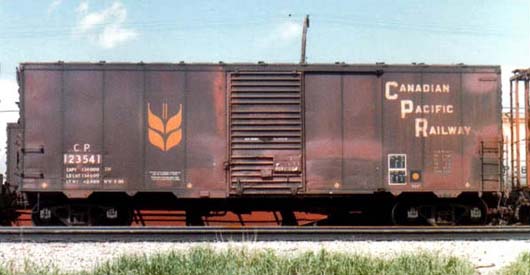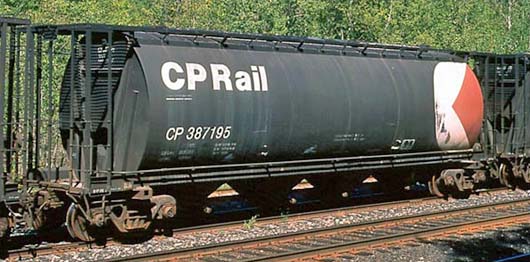|
Canadian Pacific number 123456 is a Fowler boxcar - 1935 British Columbia Archives.
CP 123456 represents a typical 36 foot long wooden boxcar
that roamed the rails carrying freight all across Canada and the U.S.A. for half a century, a few lasting
until the 1960's. These boxcars carried wheat and other grains to market along with manufactured goods of all
kinds. Wooden doors were nailed into the door openings to contain the grain during shipment.
These wooden single-sheathed steel frame boxcars had a capacity of 40 tons and a tare weight of
20 tons with 2,448 cubic feet of space and were built during the period 1896 to 1914. They were originally
outfitted with archbar Simplex trucks which later gave way to the common Bettendorf trucks shown in the photo.
Other railroads across the continent also used tens of thousands of similar cars. They were designed by W.E.
Fowler, a CPR master car builder, who later patented this weight-saving design which became known
as the Fowler boxcar.
Prior to the Fowler design, boxcars typically had wooden structural members sandwiched between an interior and
exterior wooden skin. The Fowler car eliminated the exterior layer of wood, producing a cheaper, lighter car,
that could carry a greater payload. This design also prevented grain leakage at the seam between the floor and
the side of the car.
The Fowler boxcars were generally used to carry grain and other dry bulk commodities until about 1960, when
they began to be replaced by specialized top-load bottom-discharge covered hopper
cars and later the federal government cars commonly known as Trudeau Hoppers. Dry bulk commodities shipped in
boxcars were literally poured into the open doorway of the car, into which a bulkhead four to six feet high
was inserted to form a largely closed box. When the car arrived at its destination, it was usually unloaded
by men with shovels. This was an expensive and laborious process, particularly in Canada where transportation
of grains, ores, and other dry bulk commodities were so significant to the economy.
Over time the grain boxcar fleets declined through attrition. The railways intention after 1986 was to use
them only on branchlines unable to accommodate covered hoppers.
In 1981, the number of railway boxcars and government covered hoppers in dedicated grain service were at a
break-even point, at about 13,000 each. The Grain Transportation Agency in that year predicted a
decrease of 164 cars per month, due to attrition. Canadian Pacific had 4,545 grain boxcars in 1981, 2,972 in
1985, 1,260 in 1986, 672 in 1990, 363 in 1992, and only 209 in 1993.

CP 123541 in the block lettering scheme has been repaired under the federal government rehabilitation
program is shown here in Winnipeg - 1984 Eric Gagnon.
Federal government boxcar rehabilitation schemes were undertaken in 1979 and 1980. Floors, nailable door
areas, spot welding, sliding door repairs, and spray painting was done. A yellow wheat sheaf, a smaller
version of the Trudeau Hopper scheme, was applied to the left of the door. Under it was a stencilled bilingual
message, reading in part, "Repaired with financial contribution from the government of Canada".

A modern steel plug door boxcar with permanently installed grain doors.
In a later attempt to do away with wooden grain doors nailed into common boxcars this purpose built steel plug
door boxcar was developed containing two grain doors (yellow) on each side to permit the loading of grains as
required.

A modern center flow covered hopper.

|